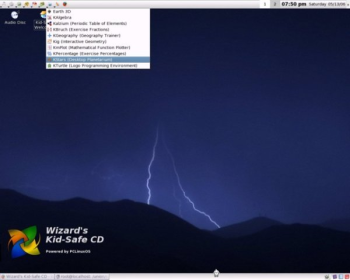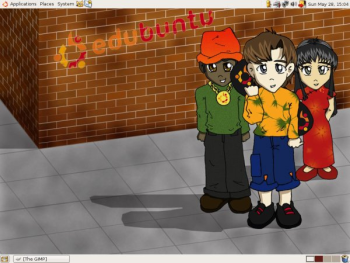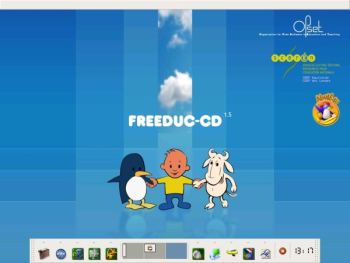Review: Linux Distributions for Children
by Lea Hudson
I have a three-year-old son who cannot resist playing on my PC at every opportunity, whether I'm there to stop him pounding the keyboard and clicking everything in sight or not! Let me tell you now, that's never a good thing in Windows. I wrote a couple of simple educational programs for him in Windows, but after hearing about a Linux distribution specifically designed for children, I decided to try something out.
I have addressed three Linux distributions: PCLinuxOS, Kidsafe, Edubuntu, and FreeDuc.
Aim: To find and install a Linux distro which provides a safe environment for my son. I'm looking for an easy install, a secure and child-friendly GUI, strictly limited Internet access and a reasonable range of software to play with. It was hard to be unbiased, but I tried to be as objective and constructive as I can with my comments.
Test PC: Compaq Deskpro PIII 1GHz with 256MB RAM and an old 3Com network card I had lying around. A 19" Iiyama CRT monitor, generic Windows keyboard and a cheap Genius optical mouse. The 20GB Hard drive was partitioned as ext3 with 1GB for swap and the remainder for root. Graphics and sound are embedded on the motherboard.
PCLOS Kidsafe 0.21-beta A nice, fast download, burned onto CD and I'm off. One of the first options I saw was whether to boot to the Live CD or into installation mode. I chose the latter as I was already familiar with PCLOS and was confident the hardware would be fine. I logged in as root because I wanted to install, but noticed that there were additional options to log in as "guest" or "kidsafe", also.
The familiar KDE desktop came up with the standard PCLOS icons along the top and a pleasant looking wheat field with a stormy sky for the wallpaper. I'll spare you the details, except to say I installed PCLOS Kidsafe in around 35 minutes, selected to delete the guest account and immediately rebooted.
I then decided to logon using the predefined "kidsafe" account instead of root. Things looked very different! Firefox opened immediately after I logged in and showed a page listing many educational and entertainment websites for kids with links to each. There were also pages giving a brief overview of this release, how to install and remaster it and contact details for the author. Very nice.

First things first, seeing as Firefox was already on screen, I searched Google for the website address of Astalavista (hacking, cracking, exploits etc.) and "Page Blocked" was displayed. OK, on to Google images and typed a few indecent words! Again, "Page Blocked". In fact, I tried a few different things and failed to get through to any malicious website or anything porn related. I realize this is not exactly the scientific way of doing things, but with the limited time I had to test the distro, it showed a level of safety I can be comfortable with. Ad and popup blocking were not installed. Whether this would be a problem considering the presence of the filtering software remains to be seen, but I'd be more comfortable with some Firefox extensions preinstalled. I doubt it would be impossible to defeat the filtering software (DansGuardian) with perseverance, but it does give the parent some peace of mind to know that reasonable measures are already in place to help keep their child safe online. Very impressive.
Next, I checked the installed software and menu items available. I imagine it's hard to judge what to choose in a remaster like this, as the selection of software you'd install for toddlers will be vastly different from what is appropriate for school age children. From what I've seen, software applications for preschool children in Linux are fairly limited. The selection provided was fine, with text editors rather than a full word processor, a couple of applications and games specifically for preschool children, and various science and school curriculum type applications for the older ones. There were also lots of typical Linux games to keep them busy. A couple of things I'd like to see added to a future releases are media/mp3 players.
Conspicuous by their absence are all the other standard menu items you'd normally see. Other than those menu selections mentioned, about the only thing you can do with PCLinuxOS kidsafe, configuration-wise, is alter the desktop settings. For that, I was grateful. I was able to gain access to the shell via CTRL, ALT, F1, etc. I don't know whether it is possible or even wise to lock users out of the shell completely in the event of a crashed application though, so no complaints on that point. A key combination like this is unlikely to be pressed by accident and the shell won't allow the child to cause too much havoc without the root password anyway.
I expected Linux running KDE to be quite slow on this old PC, but it runs very well. Everything was responsive and programs opened quickly. One or two titles were slow to render on screen but only because of the on board graphics and low speed of the PC components.
Suitable for ages: 3+ for just moving and clicking the mouse pointer and typing random characters on the keyboard along with a couple of games and a paint program, also it is recommended for any age up to teen years without their getting bored too quickly due to more advanced games and school related applications. However, Brian does say on his site that this distro is aimed at younger children. The lack of an Office suite is probably testament to that.
Verdict: I have yet to try this distro with my son at the keyboard, but I will be happy to do so and am sure he'll have a wonderful time. Children in general will be unable to do any harm to the installation if logged on to the kidsafe account, and their Internet access is as restricted as it needs to be. I really think some kind of multimedia application selection should to be added to complete this distribution. However, considering the version number for this release, I cannot fault it otherwise. It met all the requirements I was looking for, was (typical for PCLOS) very easy to install and detected and ran all the hardware correctly. Highly recommended!!
Edubuntu 6.06 - After a speedy download, Dapper Drake took almost two hours to install. Even with a relatively slow hard drive, this seemed too long for an installation from a CD. Fortunately, all went well. I doubt I'd have the patience to sit through it again though. This has to be the longest Linux installation I've ever seen and the first time I've had to input the IP address myself. All the other distros I've used have just picked one from the DHCP pool. It's not a major problem, assuming you know your network settings.

As it is stated on the Edubuntu home page that this distro is designed for classroom use, I expected there to be a restricted, predefined account for kids to use. There wasn't. I logged in with the user account I was prompted to set up during install and was surprised to see that I had access to all the menu items, including system configuration and other applications not needed by or which are unsuitable for children to play around with. Obviously, they would still have to use root access for anything critical, but I feel leaving these menus intact would allow too much freedom for kids to mess things up.
After a quick look around the uncluttered Gnome desktop, I opened Firefox. Surprisingly, I was able to access any Internet site. I searched for the URL for the Astalavista website in Google and used the same search terms in Google images again. Astalavista showed up in Google and the actual site opened with no complaints. I was also able to view some very interesting images in Google! That was not a good start. If this is a distro for kids, surely some kind of filtering provision out of the box is in order? Ad and popup blocking were also missing, as I found out when Astalavista opened. This was quite a disappointment because it means the parent or teacher has to spend time reconfiguring the security settings for the local account and install Firefox plugins to limit what a child has access to, both on and offline. Perhaps I was expecting too much, but I doubt it would be too difficult for the erson creating the remaster to add these necessary tweaks.
The range of software available immediately after installation is good, with a few nice programs like gCompris for the younger children. There were enough games and educational titles installed to keep children happy for quite a while. One inconsistency is that many of the menu items have tooltips to explain briefly what the program is about, while others don't. It's not always clear from the name what the program is designed to do, and even opening some of them doesn't yield any clues, (e.g., Keduca and Kverbos). That is more a limitation of Linux naming conventions than the fault of the developers.
Edubuntu was noticeably slow on the test PC. I'm not sure whether this is because it was running Gnome or the less than stellar system specs. Having said that, it was just about on a par with the performance I'd expect with Windows XP (also tested) on a PC this old and doesn't really cause any major problems. If I had 512Mb RAM to spare, I suspect it would run much faster.

Suitable for ages: I'd have to say the software is better for the younger children by a tiny margin because of gCompris, if nothing else. In terms of content, I think children aged 3+ are well catered for. As I stated in my verdict though, without close supervision, this distribution is not suitable for children of any age if the PC is connected to the Internet.
Verdict: This distro has a good selection of software for children but no limitation on what they can run from the menu, which is a problem for me. I really fail to see exactly how it has been customized for children. Other than adding a few educational/science applications and games with a world map wallpaper, it doesn't look any different from any other distro running Gnome. The fact that there are no restrictions in place for Internet access, no ad or popup blockers and a complete menu system is really unacceptable considering the target audience. I would have been a lot happier had there been a ready-made account for children to use. I cannot recommend this distro for children unless they are strictly supervised at all times.
Freeduc 1.5 Freeduc is a distro based on Knoppix and designed for classroom use. I downloaded the "primary school version."
I booted the Live CD and was quickly dropped straight into an XFCE desktop. I had never seen this desktop environment before and was pleasantly surprised by the layout and speed. It ran very quickly on my test box. There was a nice wallpaper showing a cartoon picture of a boy holding hands with a Gnu and Penguin. The bar docked at the bottom of the screen showed a number of icons and three virtual desktops. I began opening everything in sight and soon realized there was a problem: the whole thing was in French. According to DistroWatch, this distro is in both French and English. The official site is in English, but that's where it ends apparently.
Undeterred, I rebooted and used a cheat code to change the language to English. It didn't help. All the software and documentation I opened were still in French.
As I didn't see any initial login screen, I tried the main menu (accessed by right clicking on the desktop) to see what was installed: everything by the looks of it. It seems this distro logs the user in as root with full configuration access and full Internet access. The official site does state that it is more likely the teacher who will need access to the installed applications, but I was a little dismayed by the idea of a primary school child having root privileges. Isn't it a cardinal sin for an adult to log into Linux as root? Allowing a child to do so is asking for trouble. And why is this distro called the "primary school version?" Who exactly is it aimed at? I doubt any teacher would be able to keep tabs on a class full of children using PC's with this installed. It's a disaster waiting to happen. If it is aimed at the teacher who has only one PC and uses it with small groups of children to run educational applications and games, then it should clearly state this on the website.
As I don't speak much French, I quickly became lost and, gave up.
Suitable for ages: Hard to say. For small, closely supervised groups of French children, this distro is probably quite good!
Verdict: The GUI chosen is clean, fast and intuitive. My hardware was well supported and didn't hold it up at all. As for suitability, this distro doesn't seem to know who it is supposed to be aimed at. Either that, or I've misunderstood the comments on the official site. It isn't clear until you boot that English is not catered to, and to be logged in as root automatically really defeats the objective of having a distro for children. I cannot recommend this distribution as it meets almost none of my criteria.
PCLOS is the final distro of choice for me after trying many others for some months before discovering it. So, the first mini review is going to be the Kidsafe remaster of PCLOS by Brian "wizard" Burns.